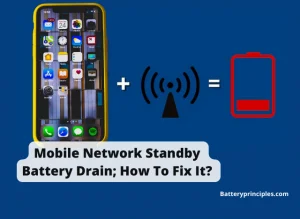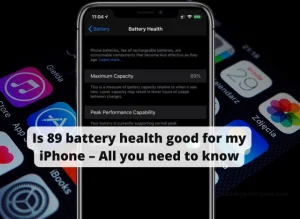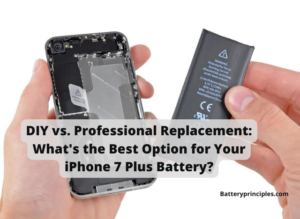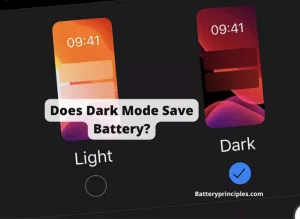Batteries do not prefer very low as well as very high temperatures. So in general, below 32 celsius degrees is not good for any kind of a mobile battery as well as temperature above 55 celsius degrees is harmful for the mobile batteries.
So when you are using your mobile phone, make sure it is not reaching over 55 degrees and under 32 degrees when you are in a cool place. Batteries give out energy by means of a chemical reaction, and for the reaction to be at its best, there must be a good temperature inside the battery.
What is the maximum battery temperature of an Android phone?
The maximum battery temperature varies from device to device. Most Android phones, on the other hand, have a maximum battery temperature of 50 °C (122 °F). If your smartphone consistently reaches 122 degrees Fahrenheit, it is at risk of being damaged.
So, as mentioned, you should keep an eye on your phone’s battery temperature to avoid reducing its health. Mostly, the battery temperature quickly increases while charging.
If you are already experiencing battery temperature problems while charging, then at least touch the back side of the phone to check whether the battery is overheating or not. It is also very good practice for you to keep an eye on your battery, whether the phone is new or old.
How much phone battery temperature is normal?
When charging, performing tasks, or sitting idle, smartphone manufacturers recommend keeping your device between 32-95 degrees Fahrenheit/0 to 35 degrees Celsius.
As we’ve discussed, 55 celcius or higher damages the battery, and below 55 celcius will not safeguard the battery either. The safe and optimal temperature for any phone’s battery is around 35 degrees Celsius.
Why does the battery temperature go up while charging?

The internal cell resistance causes a gradual temperature rise during charge, which compensates for some of the cold. When a battery is cold, its internal resistance rises, significantly increasing charge times.
The following are the things that usually cause the battery to heat up or not. Take a look at those and check whether your battery has them or not.
- The charger type that is being used.
- A rechargeable battery’s initial capacity.
- A rechargeable battery’s remaining capacity.
- The battery’s state of degeneration.
- Whether a protection cover is used or not.
And most importantly, it is very natural for the battery temperature to rise when charging. So nothing to worry when it keeps below too much heat.
There are cell and charger manufacturers who claim to be able to charge Li-ion batteries at low temperatures. However, most companies do not want to risk potential failure and liability. Yes, Li-ion batteries can charge at low temperatures, but research labs that dissect these batteries find concerning results.
Why does the battery temperature go down while charging?

The charging current may decrease as the device temperature rises due to the special overheating protection design. In this case, your device will be unable to charge or its charging level will be reduced. While charging, it is recommended that you turn off your phone/tablet.
If it is actually cool, the error is a safety warning that prevents the battery from charging when it is too hot or too cold.
That is also why, in the summer, if you have your phone on the dashboard of your car, it will shut down due to the heat. If it is at room temperature and gives that warning, it could be due to a corruption in the sensor, the OS, or a conflicting reading that is still in RAM and corrupting the data.
What is the Recycle Battery Symbol On My Android?
battery principles
What is the normal battery temperature while charging?
To avoid the possibility of Li plating, the battery should be at least 72°F when charging begins. While this is normal for this phone, you are overcharging it. High temperatures during fast charging have been reported to promote Li plating.
Why does the battery die so fast?
Many factors can cause your battery to flush quickly. If you have your screen brightness turned up, or if you’re out of Wi-Fi or cellular range, your battery may drain faster than usual. If your battery’s health has degenerated over time, it may even die quickly.
Background apps continue to function even when you are not actively using them. Virtual private network, anti-virus, health, and schedule apps are a few examples.
These apps monitor or control certain aspects of your phone without your intervention, which, while convenient, significantly drains your battery.
And most importantly, when the battery health is bad and the battery has been used for a long time without proper care, then the battery will tend to discharge more quickly than normal. This is very normal and I hope all of you have experienced that the battery discharges quickly when you have been using a phone for years.
When this happens, replacing the old battery with a new one that is brand new and original will definitely fix your problem. But if you are taking relevant measures to safeguard the battery’s health for a long time, then you will be happy at the end of the year to think that your phone’s battery is still working well.
battery principles
Some related FAQs.
At What Temperature Does A Cell Phone Battery Explode?
The chemicals inside the battery begin to heat up, causing the separator to degrade further. The battery’s temperature can eventually reach over 1,000 °F. When exposed to oxygen in the air, the flammable electrolyte can ignite or even explode.
Does Cold Weather Kill Phone Batteries?
Cold temperatures increase the impedance of a lithium battery, reducing the amount of power it can deliver.
High impedance can have a significant impact on the voltage and overall power of the battery. The good news is that these effects are only temporary, and once your phone has warmed up, its performance should return to normal.
There is no set temperature at which a phone will begin to fail. The performance of your phone in winter conditions is largely determined by the condition of the battery itself.
If your battery has undergone chemical aging (here’s that term again), it will be more vulnerable to the effects of cold. Users should try to keep their phones between 32° and 95° F as a general rule.







